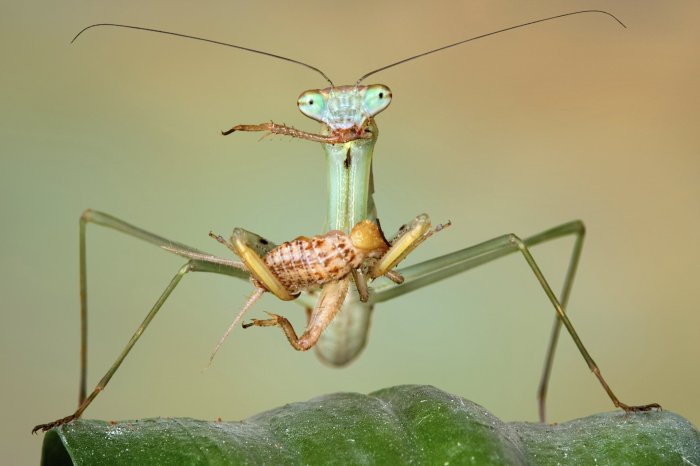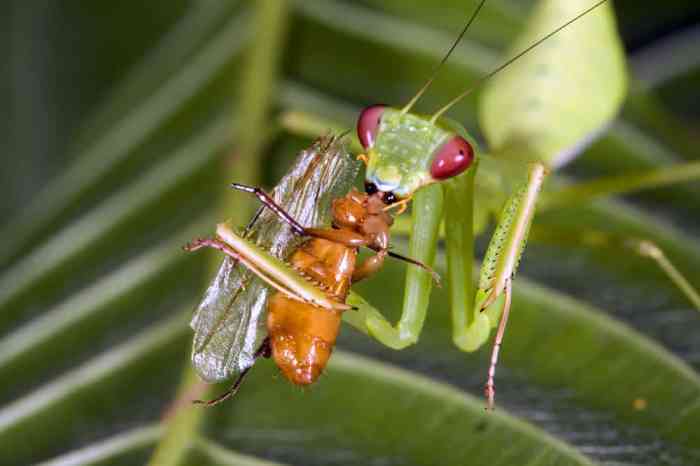Do praying mantises eat ticks? As we delve into this fascinating question, we’ll uncover the intriguing dietary habits of these predatory insects and their interactions with the parasitic ticks that plague our gardens and forests.
Praying mantises, known for their voracious appetites and impressive hunting skills, have a diverse diet that includes a wide range of insects. But do ticks make it onto their menu? Let’s explore the evidence and discover the ecological significance of this potential predator-prey relationship.
Praying Mantis Diet

Praying mantises are voracious carnivores, with a diet consisting primarily of insects. Their powerful jaws and grasping forelegs make them effective predators, capable of capturing and consuming a wide range of prey. While they typically target smaller insects, such as flies, mosquitoes, and moths, larger species of praying mantises have been known to take down larger prey, including frogs, small reptiles, and even birds.
Insect Preference, Do praying mantises eat ticks
Insects form the cornerstone of the praying mantis’s diet. Their preference for insects stems from their nutritional value and abundance in their habitats. Praying mantises actively hunt for insects, using their keen eyesight and camouflage to ambush their prey. They typically lie in wait for unsuspecting insects to approach, before striking with lightning speed to capture them with their powerful forelegs.
Tick Characteristics: Do Praying Mantises Eat Ticks

Ticks are small, wingless arachnids that belong to the order Ixodida. They are characterized by their flattened, oval-shaped bodies, which range in size from 1 to 10 millimeters.
Ticks have a leathery exoskeleton and four pairs of legs. The first pair of legs is modified into grasping claws that help them attach to their hosts. Ticks also have a pair of piercing mouthparts that they use to feed on blood.
Parasitic Nature
Ticks are obligate parasites, meaning that they must feed on the blood of other animals to survive. They typically attach to the skin of their hosts and feed for several days or even weeks. During this time, they can engorge themselves with blood, increasing their size by up to 100 times.
Ticks can transmit a variety of diseases to their hosts, including Lyme disease, Rocky Mountain spotted fever, and tularemia. They can also cause skin irritation and allergic reactions.
Blood-Feeding Habits
Ticks have a unique feeding mechanism that allows them to extract blood from their hosts without causing much pain. They insert their mouthparts into the skin of their hosts and secrete a substance that numbs the area. They then use their piercing mouthparts to cut through the skin and access the blood vessels.
Ticks can feed for several days or even weeks at a time. During this time, they can engorge themselves with blood, increasing their size by up to 100 times. Once they are full, they detach from their hosts and fall to the ground to lay their eggs.
Mantis Hunting Behavior

Praying mantises are voracious predators, renowned for their exceptional hunting abilities. They employ a combination of stealth, ambush tactics, and camouflage to capture their prey with remarkable efficiency.
Ambush Tactics
Praying mantises typically adopt an ambush strategy. They remain motionless, often swaying slightly to resemble a leaf or flower, patiently waiting for unsuspecting prey to come within striking distance. Their elongated front legs, armed with sharp spines, are held folded in a prayer-like position, ready to swiftly grasp their target.
Praying mantises are known for their voracious appetites, and ticks are no exception. These insects are ambush predators that will eat just about anything they can catch, including ticks. If you’re looking for a natural way to control ticks in your yard, consider attracting praying mantises.
You can do this by planting flowers that attract them, such as marigolds and zinnias. You can also perform a Wilcoxon rank sum test in Excel to determine if there is a significant difference in the number of ticks in areas with and without praying mantises.
Camouflage
Praying mantises possess exceptional camouflage abilities. Their bodies often mimic the color and texture of their surroundings, making them nearly indistinguishable from leaves, twigs, or flowers. This adaptation allows them to blend seamlessly into their environment, effectively concealing themselves from both predators and prey.
Tick Defense Mechanisms

Ticks have evolved a range of effective defense mechanisms to evade predators, including praying mantises. These mechanisms include camouflage, the ability to drop off hosts, and the production of toxins.
Camouflage
Ticks are often difficult to spot due to their small size and ability to blend in with their surroundings. They can change their color to match the host’s skin or fur, making them almost invisible to predators.
Dropping Off Hosts
When a tick senses a potential predator, it can quickly detach itself from the host and drop to the ground. This allows the tick to escape and find a new host.
Toxin Production
Some ticks produce toxins that can deter predators. These toxins can cause pain, swelling, and irritation, making it less likely that the predator will eat the tick.
Mantis-Tick Interactions

Praying mantises have been documented consuming ticks, demonstrating their predatory versatility. While not a primary food source, ticks occasionally fall prey to these voracious hunters.
Tick Consumption by Mantises
Specific instances of praying mantises eating ticks have been observed in various settings. In one study, researchers witnessed a Chinese mantis (Tenodera sinensis) successfully capturing and consuming a lone tick. The mantis exhibited a rapid strike and firm grip, immobilizing the tick before ingesting it.In
another observation, a European mantis (Mantis religiosa) was found to have consumed multiple ticks attached to a bird’s nest. The mantis’s keen eyesight and agile movements allowed it to locate and seize the ticks, adding them to its diverse diet.The
frequency of mantis-tick interactions remains relatively low compared to other prey items. However, these instances highlight the mantises’ opportunistic nature and their ability to adapt to different food sources when necessary.
Ecological Impact
Praying mantises’ predation on ticks has potential ecological implications. Their role in tick population control and disease transmission requires further exploration.
Tick populations may be suppressed by mantises, as they are known to consume a wide range of insects, including ticks. Reduced tick populations could lead to a decrease in the incidence of tick-borne diseases, such as Lyme disease, which can have a significant impact on human and animal health.
Role in Tick Population Control
- Mantises are opportunistic predators that consume a variety of insects, including ticks.
- By preying on ticks, mantises may reduce tick populations, potentially decreasing the risk of tick-borne diseases.
Impact on Disease Transmission
- Ticks can transmit various diseases, including Lyme disease, to humans and animals.
- By reducing tick populations, mantises may indirectly reduce the incidence of tick-borne diseases.
Detailed FAQs
Are praying mantises effective at controlling tick populations?
While praying mantises do consume ticks, their impact on tick populations is likely limited due to their relatively small numbers and preference for larger prey.
Can praying mantises transmit diseases from ticks to humans?
Praying mantises do not typically transmit diseases from ticks to humans. They are not known to carry or harbor disease-causing pathogens.
Are praying mantises harmful to humans?
Praying mantises are generally not harmful to humans. They may occasionally bite if handled roughly, but their bites are not venomous and typically cause only minor discomfort.